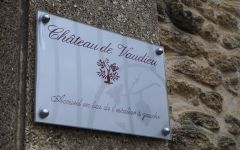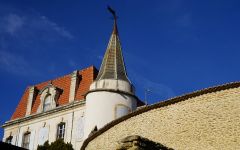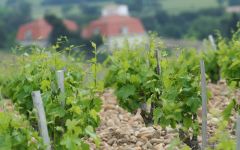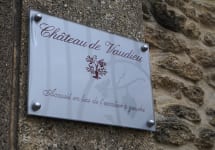Chateau de Vaudieu Chateauneuf-du-Pape 2018
- Decanter
-
Wine
Spectator -
Jeb
Dunnuck -
Robert
Parker



Product Details
Your Rating
Somm Note
Winemaker Notes
Professional Ratings
-
Decanter
Almond, black cherry and violet, this has an appealing fragrance. Very full-bodied, full of glycerol fat. Gentle Herbes de Provence line in the background, orange peel with sweet spice on the finish, but not overtly oaky. Acidity is balanced, alcohol is high but this has smooth tannins and is very glossy - will be a popular wine. Mostly aged in demi-muids, along with some old barriques.
-
Wine Spectator
Bright juicy red and black cherry fruit form the core here, with light rooibos tea, red licorice and alder accents filling in around. Fresh, fine-grained finish. Best from 2021 through 2031.
-
Jeb Dunnuck
Moving to the 2018s. the base 2018 Châteauneuf Du Pape comes from vines all around the estate, which is located in the heart of Châteauneuf du Pape. It displays the forward, sexy style of the vintage and delivers loads of kirsch liqueur, Provençal herbs, licorice, and flowery incense aromas and flavors to go with a medium-bodied, silky style on the palate. As charming and gulpable as they come, it’s ideal for enjoying over the coming 10-12 years. The blend is 46% Grenache, 34% Syrah, and 20% Mourvèdre, brought up in old barrels and concrete tank.
-
Robert Parker's Wine Advocate
Vaudieu's main cuvée, the 2018 Chateauneuf du Pape, is about 80% Grenache, 15% Syrah and 5% Mourvèdre. As usual, it's a ripe, lusty version of Châteauneuf, round and generous on the palate, with supple tannins. Black cherries pick up subtle herb and spice nuances on the softly dusty finish. It's a wine that gives pleasure now and should continue to do so for another decade.
Other Vintages
2019-
Wine
Spectator -
Jeb
Dunnuck -
Robert
Parker
-
Jeb
Dunnuck -
Wine
Spectator -
Robert
Parker
-
Wine
Enthusiast -
Wine
Spectator -
Robert
Parker -
Jeb
Dunnuck
-
Wine
Spectator -
Robert
Parker
-
Wine
Spectator -
Robert
Parker
-
Wine
Spectator -
Robert
Parker
-
Wine
Spectator -
Robert
Parker
-
Wine
Spectator -
Robert
Parker
-
Wine
Enthusiast -
Wine
Spectator -
Robert
Parker







Located about a five minute drive outside the village of Chateauneuf-du-Pape along the road which leads to Courthezon you will find Chateau de Vaudieu. It is one of three 18th century Chateaux located in the appellation, tucked into a small valley surrounded by hills and plateau. It is at the intersection of several major terroirs: sandy soils to the north, along a border it shares with Chateau Rayas (one of the best wines in Chateauneuf-du-Pape but not actually a Chateau), pale limestone and clays centered around a forested hillock, and two large plateaux of the somewhat overexposed galets. In total there are 70 hectares within one contiguous estate – something very rare in the appellation.

With bold fruit flavors and accents of sweet spice, Grenache, Syrah and Mourvèdre form the base of the classic Rhône Red Blend, while Carignan, Cinsault and Counoise often come in to play. Though they originated from France’s southern Rhône Valley, with some creative interpretation, Rhône blends have also become popular in other countries. Somm Secret—Putting their own local spin on the Rhône Red Blend, those from Priorat often include Merlot and Cabernet Sauvignon. In California, it is not uncommon to see Petite Sirah make an appearance.

Famous for its full-bodied, seductive and spicy reds with flavor and aroma characteristics reminiscent of black cherry, baked raspberry, garrigue, olive tapenade, lavender and baking spice, Châteauneuf-du-Pape is the leading sub-appellation of the southern Rhône River Valley. Large pebbles resembling river rocks, called "galets" in French, dominate most of the terrain. The stones hold heat and reflect it back up to the low-lying gobelet-trained vines. Though the galets are typical, they are not prominent in every vineyard. Chateau Rayas is the most obvious deviation with very sandy soil.
According to law, eighteen grape varieties are allowed in Châteauneuf-du-Pape and most wines are blends of some mix of these. For reds, Grenache is the star player with Mourvedre and Syrah coming typically second. Others used include Cinsault, Counoise and occasionally Muscardin, Vaccarèse, Picquepoul Noir and Terret Noir.
Only about 6-7% of wine from Châteauneuf-du-Pape is white wine. Blends and single-varietal bottlings are typically based on the soft and floral Grenache Blanc but Clairette, Bourboulenc and Roussanne are grown with some significance.
The wine of Chateauneuf-du-Pape takes its name from the relocation of the papal court to Avignon. The lore says that after moving in 1309, Pope Clément V (after whom Chateau Pape-Clément in Pessac-Léognan is named) ordered that vines were planted. But it was actually his successor, John XXII, who established the vineyards. The name however, Chateauneuf-du-Pape, translated as "the pope's new castle," didn’t really stick until the 19th century.
